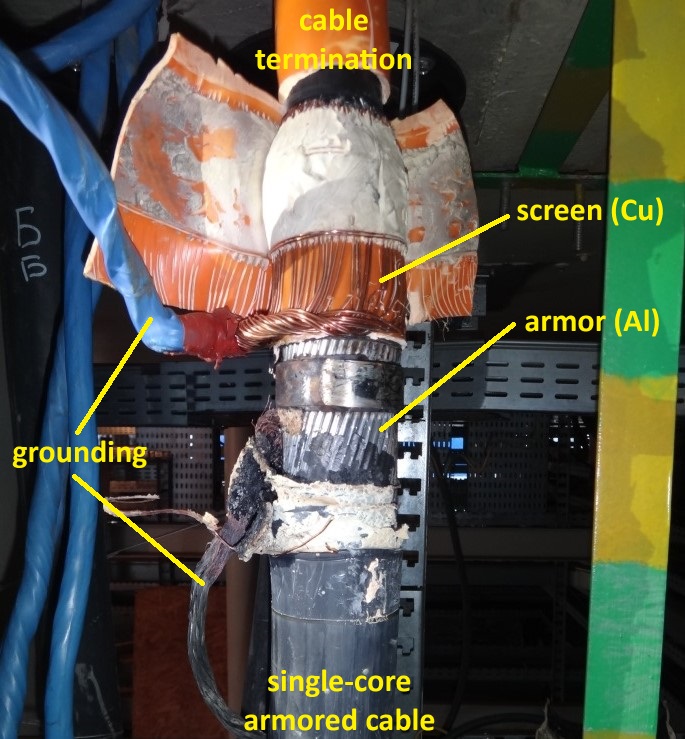
The core, the screen, the armor – which is the main one?
The photo shows cable termination of the single-core cable, which was overheated due to high currents induced in the screen and the armor. As far as you know, for single-core cables, armor can only be made of non-magnetic materials, and the photo shows aluminum allow armor that tightly covers the cable from the outside. Why do we need armor at all?
1️⃣ Increasing the maximum cable pulling forces and, hence, increasing the distances between adjacent joints (reducing the number of joints).
2️⃣ Mechanical protection of the cable from damage.
3️⃣ Cable protection in earthquake-prone areas.
4️⃣ Protection of explosive premises and factories from the consequences of a short-circuit inside the cable.

It turns out that currents are induced not only in the screen but in the armor too. Let’s consider case of 35 kV line, three single-core cables in closed triangle, Fc=630 mm2 – aluminum core, Fs=50 mm2 – copper screen, Fa=475 mm2 – armor made of aluminum alloy. The length of the line is 1.0 km (it does not matter, since the induced current does not depend on the length).
The current in the core is Ic = 600 A.
The current in the screen is Is=65 A (measured by 1 kV tongs).
The current in the armor is Ia=375 A (measured by 1 kV tongs).
The ratio of losses in the screen and core Ps/Pc=0.087 (thanks to triangle).
The ratio of losses in the armor and core Pa/Pc=0.521.
Total losses in the single-core cable are P=Pc+Ps+Pa=Pc*(1+Ps/Pc+Pa/Pc)
Let the losses in the core Pc = 1pu, and then P=(1+Ps/Pc+Pa/Pc).
Thus, we get P=1+0.087+0.521=1.61, which is 1.61 times greater than Pc=1 in the core (in case of cables flat formation P could be up to 3-4 instead of 1.61).
Well, in the case the total losses in the single-core cable are 1.6 times greater than the losses in the core. It means the main source of cable heating is not a core, but screen and armor! Let’s see what is more dangerous – the screen or the armor?
The ratio of losses in the armor and screen Pa/Ps=0.521/0.087=6.0, that is, the loss in armor is 6 times greater than the loss in the screen. So, in our example, the armor turned out to be a more important element of the line than the screen in terms of power losses. And the rejection of a simple two-side grounding is needed primarily not for the screen, but for the armor.
The photo shows an example of an overheated single-core cable with armor.
HOW TO FIX THE SITUATION?
To implement various bonding/grounding schemes:
1️⃣ One-side grounding of the armor.
2️⃣ Two-sides grounding of the armor with its cross-bonding.
3️⃣ Ungrounding of the armor at both sides (it is the best, but I don’t have enough space here to explain why it’s not dangerous to a people).
To abandon single-core cables with aluminum alloy armor, and instead:
4️⃣ Use some kind of synthetic armor.
5️⃣ Use non armored single-core cables, laying them in protective pipes.
